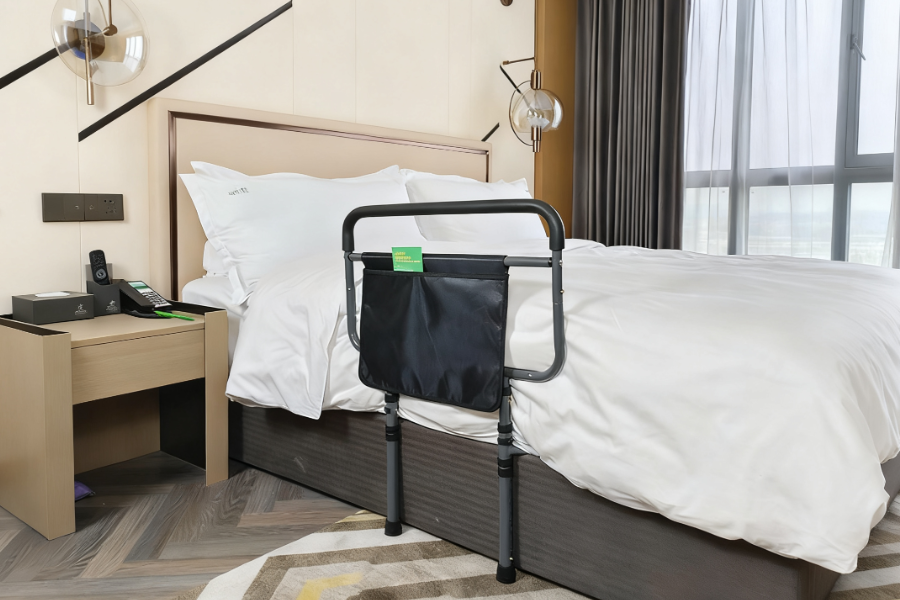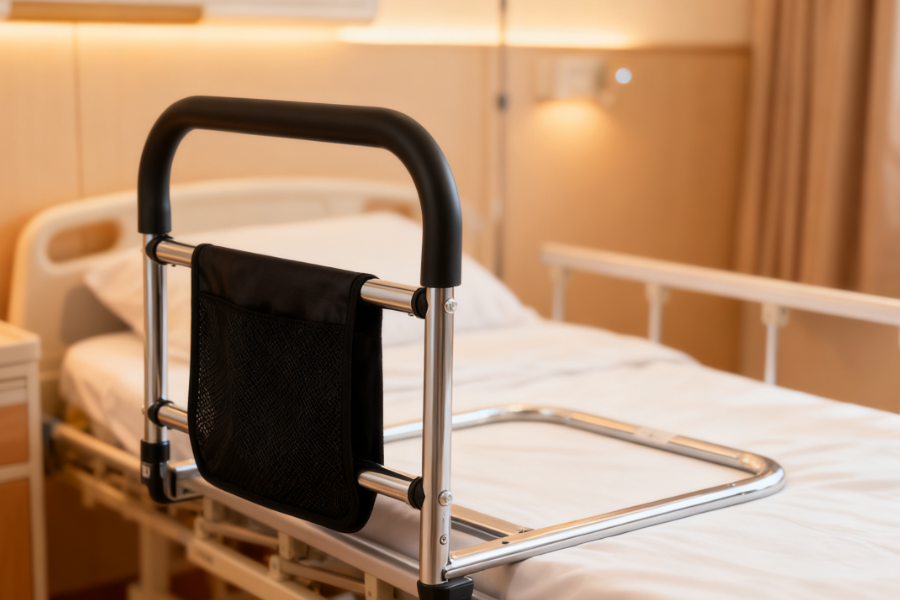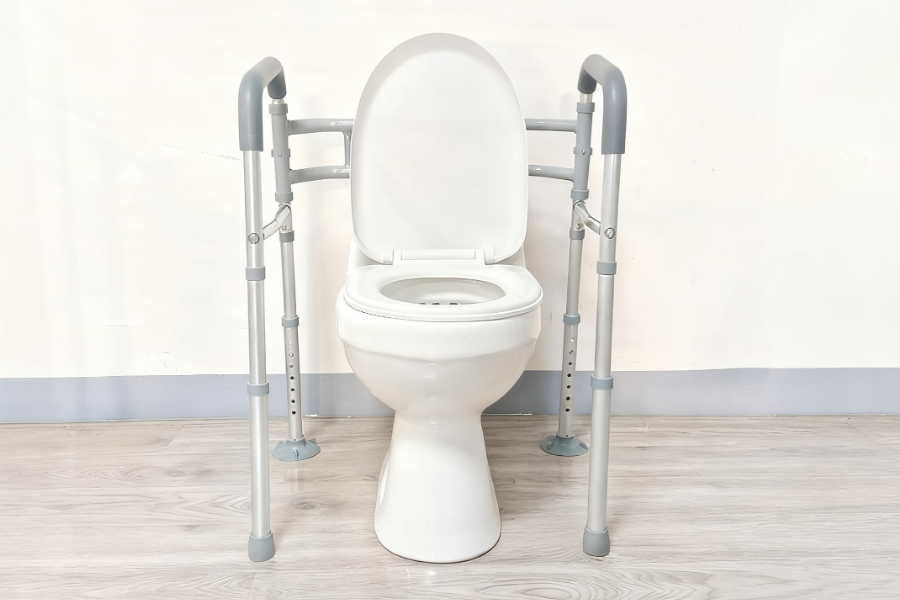With more folks getting older worldwide, nursing homes face a big challenge to keep residents safe and operations smooth. By 2035, the number of people over 60 is expected to hit 400 million globally. Falls are a huge concern. Safety rails tackle this problem head-on, offering steady support and easing the load on caregivers. They’re a must-have for any facility aiming to boost safety, independence, and efficiency.

Nursing homes handle a ton of tasks every day, from keeping residents safe to managing staff time. Safety rails are a simple, solid way to tackle these challenges. They cut down on fall-related injuries, boost resident confidence, and make daily operations smoother. Putting rails in key spots like bedrooms and bathrooms can slash these risks by up to 50%.
Falls are a constant headache in nursing homes. A single slip can lead to a broken hip or a long hospital stay, especially for folks with weak bones. Safety rails give residents a firm grip to steady themselves during moves or transfers. A rail makes it safer. Studies say well-placed rails can cut bathroom accidents nearly in half. That’s a game-changer for keeping residents out of harm’s way.
Residents want to feel in control. Safety rails let them handle tasks like getting out of bed or using the bathroom without a caregiver hovering. This freedom lifts their spirits and cuts down on staff demands. Think of a resident getting up at night without worrying about a fall. That’s what rails do.
Caregiving is tough, and staff shortages are real. Safety rails reduce the need for constant one-on-one help, letting caregivers manage more residents at once. A facility with 50 residents could save hours daily if rails help just a few move on their own. This saves money and keeps staff from burning out. They can focus on personal care instead of always watching for falls.
Bedrooms are where residents spend a lot of time, but they’re also risky spots for falls, especially at night. Bedside safety rails fix this by giving seniors a sturdy anchor when getting in or out of bed.
Nighttime is rough. Dim lights and sleepy movements make falls more likely. Bed rails act like a trusty sidekick, offering support when residents swing their legs out or stand up. The bed assist grab bar with storage pocket works with king, queen, full, or twin beds, giving residents a solid grip every time.

Not every bed or resident is the same. Some need taller rails, others shorter. Adjustable rails fit different bed types and user heights, making them perfect for all kinds of facilities. The height-adjustable bed assist rail lets you tweak the settings, so whether it’s a tall resident or a low bed, it works just right.

These rails aren’t just practical; they’re thoughtful. Made from light but strong aluminum, they last for years. Some come with handy pockets for glasses or remotes, which residents love. Their look blends into rooms without feeling like a hospital. Nursing homes can set them up fast, knowing they’re tested for toughness and safety. It’s the kind of detail that makes a difference.
Bathrooms are tricky. Wet floors and awkward moves make toileting risky for seniors. Toilet safety rails give the stability needed to sit and stand safely, easing strain on joints and cutting fall risks. For nursing homes, they’re a must for making bathrooms safe and accessible, keeping residents secure and comfortable.
Toileting can be tough for residents with weak legs or poor balance. Rails on both sides of the toilet offer a steady grip, helping them lower or rise without slipping. The heavy-duty toilet safety rails handle serious weight, giving residents confidence and saving caregivers extra worry.

Toilet rails need to work for everyone. These stand-alone models fit most toilets, from small to larger designs. Their sturdy build handles heavy loads, ideal for residents of all sizes. Nursing homes love their flexibility, as one model works across multiple bathrooms without needing special fittings. It’s a simple solution that just works.
Time matters in nursing homes. Stand-alone toilet rails don’t need drilling, so staff can pop them in place in minutes. This fast setup keeps bathrooms up and running, and residents get safer toileting right away. It’s a no-fuss way to upgrade facilities without slowing things down.
Bathrooms are a risky spot for seniors, with 53% of falls happening there. Shower safety rails act like a trusty friend, giving a steady grip in wet, soapy spaces. They’re built to be comfy and dependable, letting residents wash without worry. These rails cut down on the need for caregivers to hover nearby. The goal? Make showers safe and easy, so everyone feels at ease. Honestly, a good rail can turn a scary bath into a relaxing moment.
Wet floors and soap suds spell trouble. Shower rails offer a solid hold, stopping slips when stepping in or out of the shower. Their grippy surfaces stay steady even with soap everywhere. Picture a resident with wobbly legs. That rail is what keeps a shower from turning into a tumble. Data backs this up: rails can slash bathroom falls by nearly half. It’s a simple fix that makes a big difference in keeping folks safe.
Comfort counts a lot. Rails with smooth, hand-friendly shapes feel nice to grab and ease strain. Their non-slip surfaces hold firm in wet conditions. Some rails let you tweak the height to fit different folks. These small details make bathing less of a chore. They keep things safer, too. For example, a senior with arthritis can grip a rail without hurting their hands. It’s the kind of thoughtful touch that matters in daily life.
Nursing homes serve all sorts of residents, from those with slight mobility hiccups to others needing lots of help. Adjustable shower rails work with different heights and bathroom layouts. This means every resident can bathe comfortably. Pair them with a foldable shower chair for a setup that’s tough to top. In a busy care home, these rails fit right in, whether it’s a small shower stall or a bigger bathroom. They’re practical, flexible, and get the job done without fuss.
For safety rails, quality and trust matter. Beiqin delivers reliable products meeting ISO 13485, FDA, and CE standards, backed by 140+ patents. Their 20,000㎡ smart factory produces 6,000+ units daily with fast delivery: 3 days for prototypes, 7 days for 10,000 units. Using light, strong aluminum and carbon fiber, their rails suit busy nursing homes. Flexible OEM/ODM services customize height and color, trusted by brands like Homcom and Walgreens.
Q1: How quick is it to set up toilet safety rails?
A: Stand-alone toilet rails need no drilling. Staff can set them up in minutes, keeping bathrooms ready for use without any hassle.
Q2: Are shower rails safe in wet bathrooms?
A: Totally. Shower rails have non-slip grips and sturdy builds, staying secure even with water and soap everywhere.
Q3: Can nursing homes tweak safety rail designs?
A: Yes, OEM/ODM services let facilities customize rails for height, features, or style to fit specific resident needs and bathroom setups.
With more folks getting older worldwide, nursing homes face a big challenge to keep residents safe and operations smooth. By 2035, the number of people over 60 is expected to hit 400 million globally. Falls are a huge concern. Safety rails tackle this problem head-on, offering steady support and easing the load on caregivers. They’re a must-have for any facility aiming to boost safety, independence, and efficiency.

Nursing homes handle a ton of tasks every day, from keeping residents safe to managing staff time. Safety rails are a simple, solid way to tackle these challenges. They cut down on fall-related injuries, boost resident confidence, and make daily operations smoother. Putting rails in key spots like bedrooms and bathrooms can slash these risks by up to 50%.
Falls are a constant headache in nursing homes. A single slip can lead to a broken hip or a long hospital stay, especially for folks with weak bones. Safety rails give residents a firm grip to steady themselves during moves or transfers. A rail makes it safer. Studies say well-placed rails can cut bathroom accidents nearly in half. That’s a game-changer for keeping residents out of harm’s way.
Residents want to feel in control. Safety rails let them handle tasks like getting out of bed or using the bathroom without a caregiver hovering. This freedom lifts their spirits and cuts down on staff demands. Think of a resident getting up at night without worrying about a fall. That’s what rails do.
Caregiving is tough, and staff shortages are real. Safety rails reduce the need for constant one-on-one help, letting caregivers manage more residents at once. A facility with 50 residents could save hours daily if rails help just a few move on their own. This saves money and keeps staff from burning out. They can focus on personal care instead of always watching for falls.
Bedrooms are where residents spend a lot of time, but they’re also risky spots for falls, especially at night. Bedside safety rails fix this by giving seniors a sturdy anchor when getting in or out of bed.
Nighttime is rough. Dim lights and sleepy movements make falls more likely. Bed rails act like a trusty sidekick, offering support when residents swing their legs out or stand up. The bed assist grab bar with storage pocket works with king, queen, full, or twin beds, giving residents a solid grip every time.

Not every bed or resident is the same. Some need taller rails, others shorter. Adjustable rails fit different bed types and user heights, making them perfect for all kinds of facilities. The height-adjustable bed assist rail lets you tweak the settings, so whether it’s a tall resident or a low bed, it works just right.

These rails aren’t just practical; they’re thoughtful. Made from light but strong aluminum, they last for years. Some come with handy pockets for glasses or remotes, which residents love. Their look blends into rooms without feeling like a hospital. Nursing homes can set them up fast, knowing they’re tested for toughness and safety. It’s the kind of detail that makes a difference.
Bathrooms are tricky. Wet floors and awkward moves make toileting risky for seniors. Toilet safety rails give the stability needed to sit and stand safely, easing strain on joints and cutting fall risks. For nursing homes, they’re a must for making bathrooms safe and accessible, keeping residents secure and comfortable.
Toileting can be tough for residents with weak legs or poor balance. Rails on both sides of the toilet offer a steady grip, helping them lower or rise without slipping. The heavy-duty toilet safety rails handle serious weight, giving residents confidence and saving caregivers extra worry.

Toilet rails need to work for everyone. These stand-alone models fit most toilets, from small to larger designs. Their sturdy build handles heavy loads, ideal for residents of all sizes. Nursing homes love their flexibility, as one model works across multiple bathrooms without needing special fittings. It’s a simple solution that just works.
Time matters in nursing homes. Stand-alone toilet rails don’t need drilling, so staff can pop them in place in minutes. This fast setup keeps bathrooms up and running, and residents get safer toileting right away. It’s a no-fuss way to upgrade facilities without slowing things down.
Bathrooms are a risky spot for seniors, with 53% of falls happening there. Shower safety rails act like a trusty friend, giving a steady grip in wet, soapy spaces. They’re built to be comfy and dependable, letting residents wash without worry. These rails cut down on the need for caregivers to hover nearby. The goal? Make showers safe and easy, so everyone feels at ease. Honestly, a good rail can turn a scary bath into a relaxing moment.
Wet floors and soap suds spell trouble. Shower rails offer a solid hold, stopping slips when stepping in or out of the shower. Their grippy surfaces stay steady even with soap everywhere. Picture a resident with wobbly legs. That rail is what keeps a shower from turning into a tumble. Data backs this up: rails can slash bathroom falls by nearly half. It’s a simple fix that makes a big difference in keeping folks safe.
Comfort counts a lot. Rails with smooth, hand-friendly shapes feel nice to grab and ease strain. Their non-slip surfaces hold firm in wet conditions. Some rails let you tweak the height to fit different folks. These small details make bathing less of a chore. They keep things safer, too. For example, a senior with arthritis can grip a rail without hurting their hands. It’s the kind of thoughtful touch that matters in daily life.
Nursing homes serve all sorts of residents, from those with slight mobility hiccups to others needing lots of help. Adjustable shower rails work with different heights and bathroom layouts. This means every resident can bathe comfortably. Pair them with a foldable shower chair for a setup that’s tough to top. In a busy care home, these rails fit right in, whether it’s a small shower stall or a bigger bathroom. They’re practical, flexible, and get the job done without fuss.
For safety rails, quality and trust matter. Beiqin delivers reliable products meeting ISO 13485, FDA, and CE standards, backed by 140+ patents. Their 20,000㎡ smart factory produces 6,000+ units daily with fast delivery: 3 days for prototypes, 7 days for 10,000 units. Using light, strong aluminum and carbon fiber, their rails suit busy nursing homes. Flexible OEM/ODM services customize height and color, trusted by brands like Homcom and Walgreens.
Q1: How quick is it to set up toilet safety rails?
A: Stand-alone toilet rails need no drilling. Staff can set them up in minutes, keeping bathrooms ready for use without any hassle.
Q2: Are shower rails safe in wet bathrooms?
A: Totally. Shower rails have non-slip grips and sturdy builds, staying secure even with water and soap everywhere.
Q3: Can nursing homes tweak safety rail designs?
A: Yes, OEM/ODM services let facilities customize rails for height, features, or style to fit specific resident needs and bathroom setups.
Share To:
related articles
You can contact us any way that ls convenient for you.